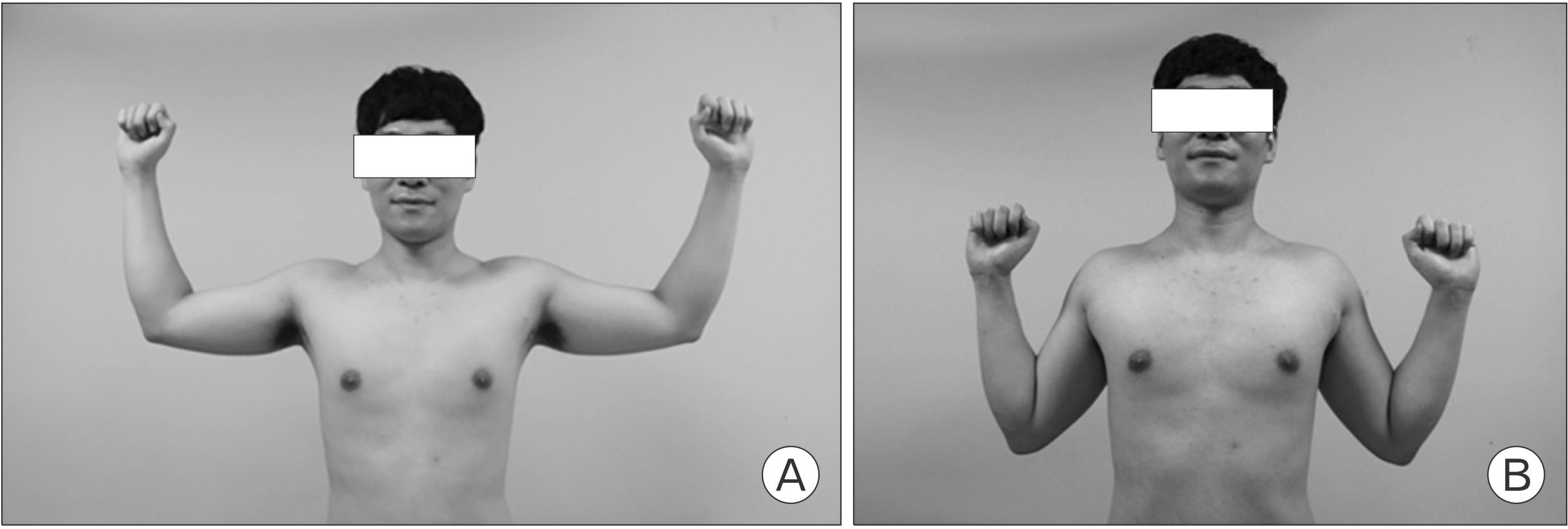Korean J Sports Med.
2020 Dec;38(4):199-207. 10.5763/kjsm.2020.38.4.199.
Changes in Shoulder Muscle Activities Depending on Static and Dynamic Body Positions during Shoulder External Rotation Exercises Using Kinetic Chain Concept
- Affiliations
-
- 1Department of Orthopaedic Surgery, Konkuk University Hospital, Konkuk University School of Medicine, Seoul, Korea
- KMID: 2509018
- DOI: http://doi.org/10.5763/kjsm.2020.38.4.199
Abstract
- Purpose
We aimed to evaluate shoulder muscle activities during shoulder external rotation exercises using an elastic band with the arm at the side or at 90° of abduction in static and dynamic body positions.
Methods
In 2017, a total of 19 right-handed male subjects were included in this study. Surface electromyography signals were recorded from the anterior deltoid, middle deltoid, upper trapezius, lower trapezius, serratus anterior, and infraspinatus muscles. The subjects underwent maximal voluntary isometric contraction testing of each muscle in the W position or 90/90 position. Subjects performed the exercise in the sitting, static squat, static rotational squat, dynamic squat to standing (DSS), and dynamic squat to standing and trunk rotation (DSSR) positions.
Results
The main finding of this study was that shoulder external rotation exercises in the DSSR position were effective in reducing shoulder muscle activities except in the serratus anterior compared with static rotational squat position.
Conclusion
DSSR enabled effective control of scapular motion with less shoulder muscle activation. Therefore, the kinetic chain exercises incorporated with lower extremity, hip, or trunk would be beneficial for shoulder muscle exercises, which is required for patients with weak periscapular muscles, in whom the lower trapezius activities were found to be frequently decreased.
Keyword
Figure
Reference
-
1. Cudlip AC, Callaghan JP, Dickerson CR. 2015; Effects of sitting and standing on upper extremity physical exposures in materials handling tasks. Ergonomics. 58:1637–46. DOI: 10.1080/00140139.2015.1035763. PMID: 25993653.
Article2. De Mey K, Danneels L, Cagnie B, Van den Bosch L, Flier J, Cools AM. 2013; Kinetic chain influences on upper and lower trapezius muscle activation during eight variations of a scapular retraction exercise in overhead athletes. J Sci Med Sport. 16:65–70. DOI: 10.1016/j.jsams.2012.04.008. PMID: 22658589.
Article3. Fernandez-Fernandez J, Ellenbecker T, Sanz-Rivas D, Ulbricht A, Ferrautia A. 2013; Effects of a 6-week junior tennis conditioning program on service velocity. J Sports Sci Med. 12:232–9. PMID: 24149801. PMCID: PMC3761833.4. Kibler WB, Sciascia AD, Uhl TL, Tambay N, Cunningham T. 2008; Electromyographic analysis of specific exercises for scapular control in early phases of shoulder rehabilitation. Am J Sports Med. 36:1789–98. DOI: 10.1177/0363546508316281. PMID: 18469224.
Article5. De Mey K, Danneels L, Cagnie B, Cools AM. 2012; Scapular muscle rehabilitation exercises in overhead athletes with impingement symptoms: effect of a 6-week training program on muscle recruitment and functional outcome. Am J Sports Med. 40:1906–15. DOI: 10.1177/0363546512453297. PMID: 22785606.6. Yamauchi T, Hasegawa S, Matsumura A, Nakamura M, Ibuki S, Ichihashi N. 2015; The effect of trunk rotation during shoulder exercises on the activity of the scapular muscle and scapular kinematics. J Shoulder Elbow Surg. 24:955–64. DOI: 10.1016/j.jse.2014.10.010. PMID: 25556806.
Article7. Nakamura Y, Tsuruike M, Ellenbecker TS. 2016; Electromyographic activity of scapular muscle control in free-motion exercise. J Athl Train. 51:195–204. DOI: 10.4085/1062-6050-51.4.10. PMID: 26986055. PMCID: PMC4852525.
Article8. Hintermeister RA, Lange GW, Schultheis JM, Bey MJ, Hawkins RJ. 1998; Electromyographic activity and applied load during shoulder rehabilitation exercises using elastic resistance. Am J Sports Med. 26:210–20. DOI: 10.1177/03635465980260021001. PMID: 9548114.9. Hughes CJ, Hurd K, Jones A, Sprigle S. 1999; Resistance properties of Thera-Band tubing during shoulder abduction exercise. J Orthop Sports Phys Ther. 29:413–20. DOI: 10.2519/jospt.1999.29.7.413. PMID: 10416181.
Article10. Page PA, Lamberth J, Abadie B, Boling R, Collins R, Linton R. 1993; Posterior rotator cuff strengthening using theraband(r) in a functional diagonal pattern in collegiate baseball pitchers. J Athl Train. 28:346–54. PMID: 16558251. PMCID: PMC1317739.11. van den Noort JC, Wiertsema SH, Hekman KM, Schonhuth CP, Dekker J, Harlaar J. 2014; Reliability and precision of 3D wireless measurement of scapular kinematics. Med Biol Eng Comput. 52:921–31. DOI: 10.1007/s11517-014-1186-2. PMID: 25192921.
Article12. Kendall FP, McCreary EK, Provance PG. 1993. Muscles testing and function. 4th ed. Williams & Wilkins;Baltimore (MD):13. Tsuruike M, Ellenbecker TS. 2015; Serratus anterior and lower trapezius muscle activities during multi-joint isotonic scapular exercises and isometric contractions. J Athl Train. 50:199–210. DOI: 10.4085/1062-6050-49.3.80. PMID: 25689561. PMCID: PMC4495440.
Article14. Kibler WB, Ludewig PM, McClure PW, Michener LA, Bak K, Sciascia AD. 2013; Clinical implications of scapular dyskinesis in shoulder injury: the 2013 consensus statement from the 'Scapular Summit'. Br J Sports Med. 47:877–85. DOI: 10.1136/bjsports-2013-092425. PMID: 23580420.
Article15. Cools AM, Struyf F, De Mey K, Maenhout A, Castelein B, Cagnie B. 2014; Rehabilitation of scapular dyskinesis: from the office worker to the elite overhead athlete. Br J Sports Med. 48:692–7. DOI: 10.1136/bjsports-2013-092148. PMID: 23687006.
Article16. Cools AM, Witvrouw EE, Declercq GA, Danneels LA, Cambier DC. 2003; Scapular muscle recruitment patterns: trapezius muscle latency with and without impingement symptoms. Am J Sports Med. 31:542–9. DOI: 10.1177/03635465030310041101. PMID: 12860542.
Article17. Ludewig PM, Cook TM. 2000; Alterations in shoulder kinematics and associated muscle activity in people with symptoms of shoulder impingement. Phys Ther. 80:276–91. DOI: 10.1093/ptj/80.3.276. PMID: 10696154.
Article18. Struyf F, Cagnie B, Cools A, et al. 2014; Scapulothoracic muscle activity and recruitment timing in patients with shoulder impingement symptoms and glenohumeral instability. J Electromyogr Kinesiol. 24:277–84. DOI: 10.1016/j.jelekin.2013.12.002. PMID: 24389333.
Article
- Full Text Links
- Actions
-
Cited
- CITED
-
- Close
- Share
- Similar articles
-
- Scapular Dyskinesis
- Effects of elevation on shoulder joint motion: comparison of dynamic and static conditions
- Effects of Muscle Fatigue on Shoulder Proprioception
- Effect of Neck Rotating Directions on the Muscle Activity of Upper and Lower Trapezius during Shoulder External Rotation
- Effects of Thoracic Spine Mobility Exercise on Symptom Improvement and Scapular Position in Patient with Subacromial Impingement Syndrome




